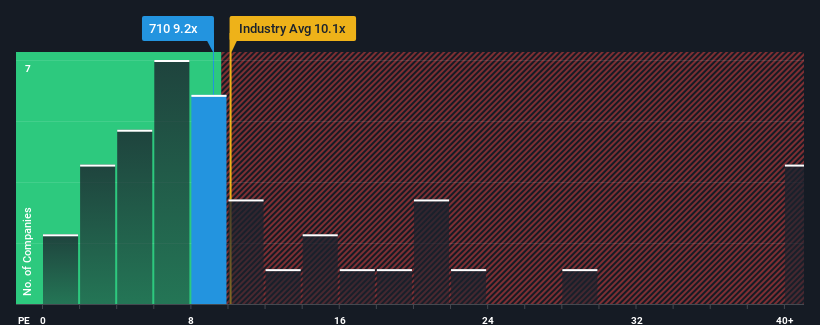
BOE Varitronix Limited (HKG:710) shareholders won't be pleased to see that the share price has had a very rough month, dropping 37% and undoing the prior period's positive performance. Longer-term shareholders would now have taken a real hit with the stock declining 4.0% in the last year.
In spite of the heavy fall in price, you could still be forgiven for feeling indifferent about BOE Varitronix's P/E ratio of 9.2x, since the median price-to-earnings (or "P/E") ratio in Hong Kong is also close to 11x. Although, it's not wise to simply ignore the P/E without explanation as investors may be disregarding a distinct opportunity or a costly mistake.
BOE Varitronix hasn't been tracking well recently as its declining earnings compare poorly to other companies, which have seen some growth on average. One possibility is that the P/E is moderate because investors think this poor earnings performance will turn around. If not, then existing shareholders may be a little nervous about the viability of the share price.
Check out our latest analysis for BOE Varitronix

How Is BOE Varitronix's Growth Trending?
There's an inherent assumption that a company should be matching the market for P/E ratios like BOE Varitronix's to be considered reasonable.
If we review the last year of earnings, dishearteningly the company's profits fell to the tune of 18%. This has soured the latest three-year period, which nevertheless managed to deliver a decent 9.6% overall rise in EPS. Accordingly, while they would have preferred to keep the run going, shareholders would be roughly satisfied with the medium-term rates of earnings growth.
Turning to the outlook, the next three years should generate growth of 21% per annum as estimated by the eight analysts watching the company. Meanwhile, the rest of the market is forecast to only expand by 14% per annum, which is noticeably less attractive.
With this information, we find it interesting that BOE Varitronix is trading at a fairly similar P/E to the market. It may be that most investors aren't convinced the company can achieve future growth expectations.
The Key Takeaway
With its share price falling into a hole, the P/E for BOE Varitronix looks quite average now. It's argued the price-to-earnings ratio is an inferior measure of value within certain industries, but it can be a powerful business sentiment indicator.
Our examination of BOE Varitronix's analyst forecasts revealed that its superior earnings outlook isn't contributing to its P/E as much as we would have predicted. There could be some unobserved threats to earnings preventing the P/E ratio from matching the positive outlook. At least the risk of a price drop looks to be subdued, but investors seem to think future earnings could see some volatility.
Before you take the next step, you should know about the 2 warning signs for BOE Varitronix that we have uncovered.
Of course, you might find a fantastic investment by looking at a few good candidates. So take a peek at this free list of companies with a strong growth track record, trading on a low P/E.
Have feedback on this article? Concerned about the content? Get in touch with us directly. Alternatively, email editorial-team (at) simplywallst.com.
This article by Simply Wall St is general in nature. We provide commentary based on historical data and analyst forecasts only using an unbiased methodology and our articles are not intended to be financial advice. It does not constitute a recommendation to buy or sell any stock, and does not take account of your objectives, or your financial situation. We aim to bring you long-term focused analysis driven by fundamental data. Note that our analysis may not factor in the latest price-sensitive company announcements or qualitative material. Simply Wall St has no position in any stocks mentioned.